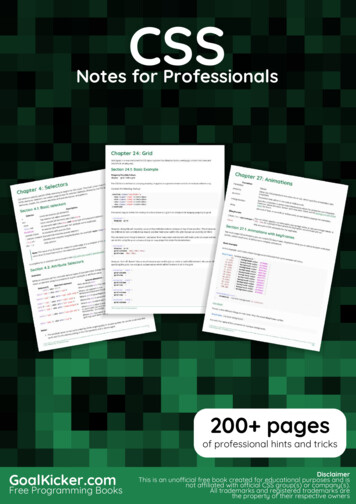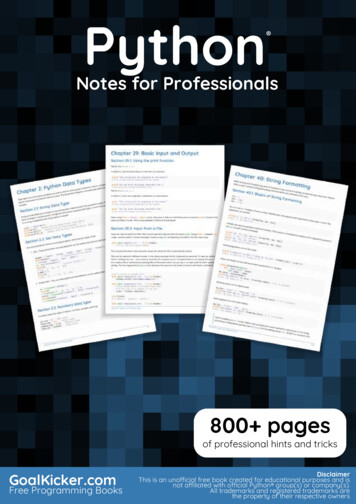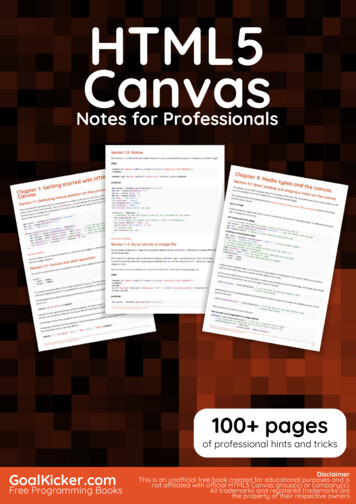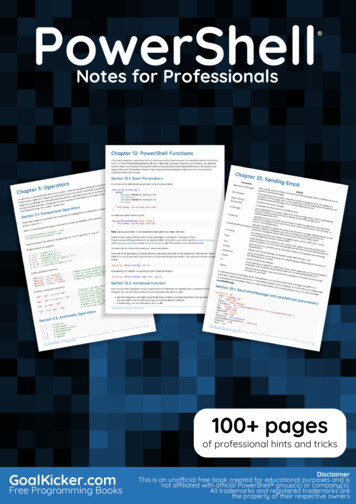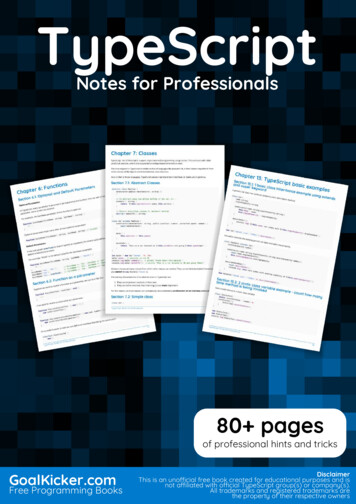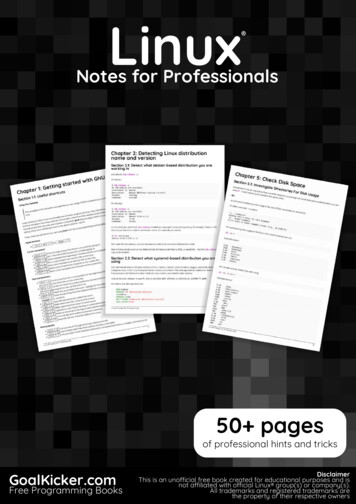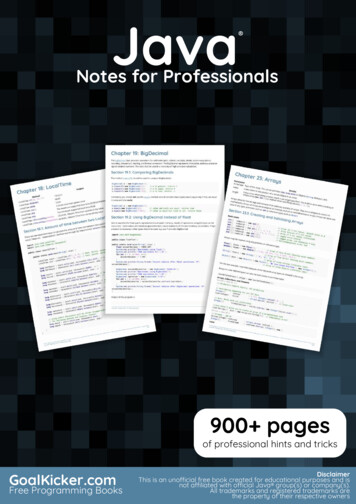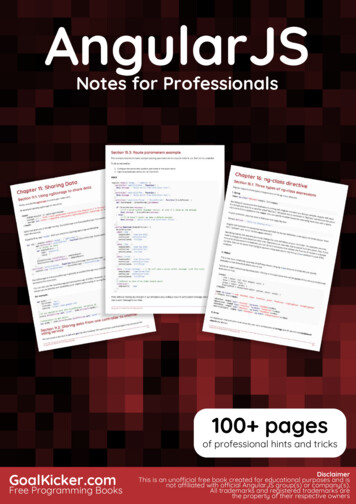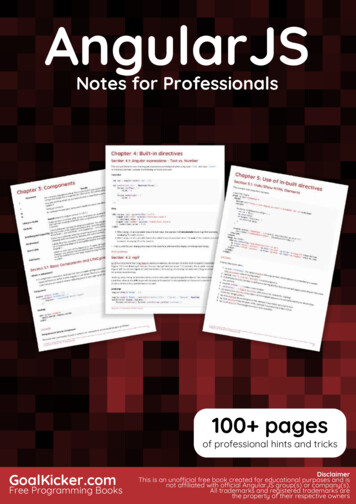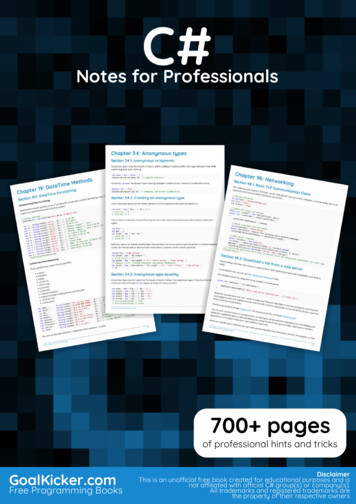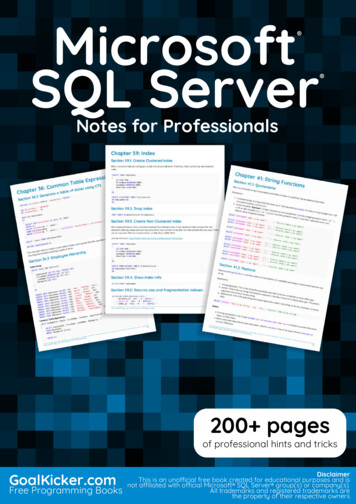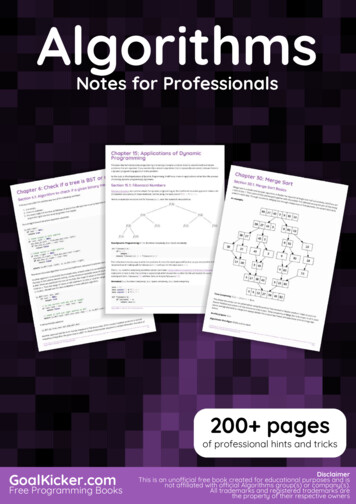
Transcription
AlgorithmsAlgorithmsNotes for ProfessionalsNotes for Professionals200 pagesof professional hints and tricksGoalKicker.comFree Programming BooksDisclaimerThis is an uno cial free book created for educational purposes and isnot a liated with o cial Algorithms group(s) or company(s).All trademarks and registered trademarks arethe property of their respective owners
ContentsAbout . 1Chapter 1: Getting started with algorithms . 2Section 1.1: A sample algorithmic problem . 2Section 1.2: Getting Started with Simple Fizz Buzz Algorithm in Swift . 2Chapter 2: Algorithm Complexity . 5Section 2.1: Big-Theta notation . 5Section 2.2: Comparison of the asymptotic notations . 6Section 2.3: Big-Omega Notation . 6Chapter 3: Big-O Notation . 8Section 3.1: A Simple Loop . 9Section 3.2: A Nested Loop . 9Section 3.3: O(log n) types of Algorithms . 10Section 3.4: An O(log n) example . 12Chapter 4: Trees . 14Section 4.1: Typical anary tree representation . 14Section 4.2: Introduction . 14Section 4.3: To check if two Binary trees are same or not . 15Chapter 5: Binary Search Trees . 18Section 5.1: Binary Search Tree - Insertion (Python) . 18Section 5.2: Binary Search Tree - Deletion(C ) . 20Section 5.3: Lowest common ancestor in a BST . 21Section 5.4: Binary Search Tree - Python . 22Chapter 6: Check if a tree is BST or not . 24Section 6.1: Algorithm to check if a given binary tree is BST . 24Section 6.2: If a given input tree follows Binary search tree property or not . 25Chapter 7: Binary Tree traversals . 26Section 7.1: Level Order traversal - Implementation . 26Section 7.2: Pre-order, Inorder and Post Order traversal of a Binary Tree . 27Chapter 8: Lowest common ancestor of a Binary Tree . 29Section 8.1: Finding lowest common ancestor . 29Chapter 9: Graph . 30Section 9.1: Storing Graphs (Adjacency Matrix) . 30Section 9.2: Introduction To Graph Theory . 33Section 9.3: Storing Graphs (Adjacency List) . 37Section 9.4: Topological Sort . 39Section 9.5: Detecting a cycle in a directed graph using Depth First Traversal . 40Section 9.6: Thorup's algorithm . 41Chapter 10: Graph Traversals . 43Section 10.1: Depth First Search traversal function . 43Chapter 11: Dijkstra’s Algorithm . 44Section 11.1: Dijkstra's Shortest Path Algorithm . 44Chapter 12: A* Pathfinding . 49Section 12.1: Introduction to A* . 49Section 12.2: A* Pathfinding through a maze with no obstacles . 49Section 12.3: Solving 8-puzzle problem using A* algorithm . 56
Chapter 13: A* Pathfinding Algorithm . 59Section 13.1: Simple Example of A* Pathfinding: A maze with no obstacles . 59Chapter 14: Dynamic Programming . 66Section 14.1: Edit Distance . 66Section 14.2: Weighted Job Scheduling Algorithm . 66Section 14.3: Longest Common Subsequence . 70Section 14.4: Fibonacci Number . 71Section 14.5: Longest Common Substring . 72Chapter 15: Applications of Dynamic Programming . 73Section 15.1: Fibonacci Numbers . 73Chapter 16: Kruskal's Algorithm . 76Section 16.1: Optimal, disjoint-set based implementation . 76Section 16.2: Simple, more detailed implementation . 77Section 16.3: Simple, disjoint-set based implementation . 77Section 16.4: Simple, high level implementation . 77Chapter 17: Greedy Algorithms . 79Section 17.1: Hu man Coding . 79Section 17.2: Activity Selection Problem . 82Section 17.3: Change-making problem . 84Chapter 18: Applications of Greedy technique . 86Section 18.1: O ine Caching . 86Section 18.2: Ticket automat . 94Section 18.3: Interval Scheduling . 97Section 18.4: Minimizing Lateness . 101Chapter 19: Prim's Algorithm . 105Section 19.1: Introduction To Prim's Algorithm . 105Chapter 20: Bellman–Ford Algorithm . 113Section 20.1: Single Source Shortest Path Algorithm (Given there is a negative cycle in a graph) . 113Section 20.2: Detecting Negative Cycle in a Graph . 116Section 20.3: Why do we need to relax all the edges at most (V-1) times . 118Chapter 21: Line Algorithm . 121Section 21.1: Bresenham Line Drawing Algorithm . 121Chapter 22: Floyd-Warshall Algorithm . 124Section 22.1: All Pair Shortest Path Algorithm . 124Chapter 23: Catalan Number Algorithm . 127Section 23.1: Catalan Number Algorithm Basic Information . 127Chapter 24: Multithreaded Algorithms . 129Section 24.1: Square matrix multiplication multithread . 129Section 24.2: Multiplication matrix vector multithread . 129Section 24.3: merge-sort multithread . 129Chapter 25: Knuth Morris Pratt (KMP) Algorithm . 131Section 25.1: KMP-Example . 131Chapter 26: Edit Distance Dynamic Algorithm . 133Section 26.1: Minimum Edits required to convert string 1 to string 2 . 133Chapter 27: Online algorithms . 136Section 27.1: Paging (Online Caching) . 137Chapter 28: Sorting . 143Section 28.1: Stability in Sorting . 143
Chapter 29: Bubble Sort . 144Section 29.1: Bubble Sort . 144Section 29.2: Implementation in C & C . 144Section 29.3: Implementation in C# . 145Section 29.4: Python Implementation . 146Section 29.5: Implementation in Java . 147Section 29.6: Implementation in Javascript . 147Chapter 30: Merge Sort . 149Section 30.1: Merge Sort Basics . 149Section 30.2: Merge Sort Implementation in Go . 150Section 30.3: Merge Sort Implementation in C & C# . 150Section 30.4: Merge Sort Implementation in Java . 152Section 30.5: Merge Sort Implementation in Python . 153Section 30.6: Bottoms-up Java Implementation . 154Chapter 31: Insertion Sort . 156Section 31.1: Haskell Implementation . 156Chapter 32: Bucket Sort . 157Section 32.1: C# Implementation . 157Chapter 33: Quicksort . 158Section 33.1: Quicksort Basics . 158Section 33.2: Quicksort in Python . 160Section 33.3: Lomuto partition java implementation . 160Chapter 34: Counting Sort . 162Section 34.1: Counting Sort Basic Information . 162Section 34.2: Psuedocode Implementation . 162Chapter 35: Heap Sort . 164Section 35.1: C# Implementation . 164Section 35.2: Heap Sort Basic Information . 164Chapter 36: Cycle Sort . 166Section 36.1: Pseudocode Implementation . 166Chapter 37: Odd-Even Sort . 167Section 37.1: Odd-Even Sort Basic Information . 167Chapter 38: Selection Sort . 170Section 38.1: Elixir Implementation . 170Section 38.2: Selection Sort Basic Information . 170Section 38.3: Implementation of Selection sort in C# . 172Chapter 39: Searching . 174Section 39.1: Binary Search . 174Section 39.2: Rabin Karp . 175Section 39.3: Analysis of Linear search (Worst, Average and Best Cases) . 176Section 39.4: Binary Search: On Sorted Numbers . 178Section 39.5: Linear search . 178Chapter 40: Substring Search . 180Section 40.1: Introduction To Knuth-Morris-Pratt (KMP) Algorithm . 180Section 40.2: Introduction to Rabin-Karp Algorithm . 183Section 40.3: Python Implementation of KMP algorithm . 186Section 40.4: KMP Algorithm in C . 187Chapter 41: Breadth-First Search . 190
Section 41.1: Finding the Shortest Path from Source to other Nodes . 190Section 41.2: Finding Shortest Path from Source in a 2D graph . 196Section 41.3: Connected Components Of Undirected Graph Using BFS . 197Chapter 42: Depth First Search . 202Section 42.1: Introduction To Depth-First Search . 202Chapter 43: Hash Functions . 207Section 43.1: Hash codes for common types in C# . 207Section 43.2: Introduction to hash functions . 208Chapter 44: Travelling Salesman . 210Section 44.1: Brute Force Algorithm . 210Section 44.2: Dynamic Programming Algorithm . 210Chapter 45: Knapsack Problem . 212Section 45.1: Knapsack Problem Basics . 212Section 45.2: Solution Implemented in C# . 212Chapter 46: Equation Solving . 214Section 46.1: Linear Equation . 214Section 46.2: Non-Linear Equation . 216Chapter 47: Longest Common Subsequence . 220Section 47.1: Longest Common Subsequence Explanation . 220Chapter 48: Longest Increasing Subsequence . 225Section 48.1: Longest Increasing Subsequence Basic Information . 225Chapter 49: Check two strings are anagrams . 228Section 49.1: Sample input and output . 228Section 49.2: Generic Code for Anagrams . 229Chapter 50: Pascal's Triangle . 231Section 50.1: Pascal triangle in C . 231Chapter 51: Algo:- Print a m*n matrix in square wise . 232Section 51.1: Sample Example . 232Section 51.2: Write the generic code . 232Chapter 52: Matrix Exponentiation . 233Section 52.1: Matrix Exponentiation to Solve Example Problems . 233Chapter 53: polynomial-time bounded algorithm for Minimum Vertex Cover . 237Section 53.1: Algorithm Pseudo Code . 237Chapter 54: Dynamic Time Warping . 238Section 54.1: Introduction To Dynamic Time Warping . 238Chapter 55: Fast Fourier Transform . 242Section 55.1: Radix 2 FFT . 242Section 55.2: Radix 2 Inverse FFT . 247Appendix A: Pseudocode . 249Section A.1: Variable a ectations . 249Section A.2: Functions . 249Credits . 250You may also like . 252
AboutPlease feel free to share this PDF with anyone for free,latest version of this book can be downloaded from:https://goalkicker.com/AlgorithmsBookThis Algorithms Notes for Professionals book is compiled from Stack OverflowDocumentation, the content is written by the beautiful people at Stack Overflow.Text content is released under Creative Commons BY-SA, see credits at the endof this book whom contributed to the various chapters. Images may be copyrightof their respective owners unless otherwise specifiedThis is an unofficial free book created for educational purposes and is notaffiliated with official Algorithms group(s) or company(s) nor Stack Overflow. Alltrademarks and registered trademarks are the property of their respectivecompany ownersThe information presented in this book is not guaranteed to be correct noraccurate, use at your own riskPlease send feedback and corrections to web@petercv.comGoalKicker.com – Algorithms Notes for Professionals1
Chapter 1: Getting started with algorithmsSection 1.1: A sample algorithmic problemAn algorithmic problem is specified by describing the complete set of instances it must work on and of its outputafter running on one of these instances. This distinction, between a problem and an instance of a problem, isfundamental.
Algorithms Algorithms Notes for Professionals Notes for Professionals GoalKicker.com Free Programming Books Disclaimer This is an uno cial free book created for educational purposes and is not a liated with o cial Algorithms group(s) or company(s). All trademarks and registered trademar
